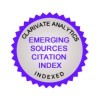Hatay İlinde Üniversite Hastanesi Endokrin Polikliniğine Başvuran Diyabet Hastalarının Bitkisel Ürün Kullanımı
Abstract
References
- Redox Proteomics: A Key Tool for New Insights into Protein Modification with Relevance to Disease
- DA Butterfield, M Perluigi - Antioxidants and Redox Signaling, 2017 - online.liebertpub.com
- Mary Ann Liebert, Inc. is committed to working closely with librarians to create collections of content
- that fulfill the informational needs of institutions while providing excellent value. ... To cite this
- article: Butterfield D. Allan and Perluigi Marzia. Antioxidants & Redox Signaling. January
- Alıntı yap Kaydet
- 18. Yazdanparast R, Ardestani A, Jamshidi S. Experimental diabetes treated with Achillea santolina: effect on pancreatic oxidative parameters. J Ethnopharmacol. 2007; 30;112(1):13-8
The Use of Herbal Supplements of Diyabetic Patients Attending the University Hospital in Hatay, Endocrine Polyclinic
Abstract
HERBAL
SUPPLEMENTS USE IN DIABETIC PATIENTS
Abstract
Aim: Complementary and alternative medicine (CAM) has
recently become more and more widespread around the world. CAM is a broad term
that refers to all the medical healthcare services, methods, and practices that
are not part of standard medical care as well as their accompanying theories
and beliefs. The present study aimed to investigate the use of herbal
supplements in diabetic patients as well as the methods of administration and
the side effects of the products.
Materials and Methods: The
cross-descriptive study was carried out from May to June 2016 and enrolled 150
patients aged over 18 years who applied to Mustafa Kemal University Medical
Hospital Endocrinology Outpatients.
Results: Of the 150 participants, 60.7% (n:91) were male while
39.3% (n:59) were female and 22% (n:33) of them reported herbal supplement use.
The most preferred supplements were, cinnamon 5.3% (n:8), lemon 4.7% (n:7),
pomegranate syrup 3.3% (n:5), green tea 2.7%
(n:4), 2.0% almond (n:3), 1.3% (n:2) yarrow, sage and olive leaves. None
of them declared a colsultation about these CAM with their GPs. Also none of
them declared a side effect.
Conclusion:
Herbal supplements are used by a great majority of diabetic patients, but none
of them were using herbal supplements by physician advice. The use of herbal
supplements without physician control may lead to undesirable outcomes for
diabetic patients.
Keywords: Diabetic
patients, use of herbal supplements, survey
Keywords
References
- Redox Proteomics: A Key Tool for New Insights into Protein Modification with Relevance to Disease
- DA Butterfield, M Perluigi - Antioxidants and Redox Signaling, 2017 - online.liebertpub.com
- Mary Ann Liebert, Inc. is committed to working closely with librarians to create collections of content
- that fulfill the informational needs of institutions while providing excellent value. ... To cite this
- article: Butterfield D. Allan and Perluigi Marzia. Antioxidants & Redox Signaling. January
- Alıntı yap Kaydet
- 18. Yazdanparast R, Ardestani A, Jamshidi S. Experimental diabetes treated with Achillea santolina: effect on pancreatic oxidative parameters. J Ethnopharmacol. 2007; 30;112(1):13-8
Details
| Primary Language | Turkish |
|---|---|
| Subjects | Health Care Administration |
| Journal Section | Articles |
| Authors | |
| Publication Date | September 22, 2017 |
| Acceptance Date | August 9, 2017 |
| Published in Issue | Year 2017 Volume: 9 Issue: 3 |
Cite
Cited By
Evaluation of the use and awareness of herbal products of the patients applying to the faculty of dentistry
Adıyaman Üniversitesi Sağlık Bilimleri Dergisi
Miray EGE
https://doi.org/10.30569/adiyamansaglik.913016
Tip 2 Diabetes Mellituslu Hastaların Bitkisel Destek Kullanım Durumları
Akdeniz Medical Journal
Ezgi BELLİKCİ-KOYU
https://doi.org/10.53394/akd.979533
Ayrık Otuna Yer Açmak: Geleneksel Tıp ve Hasta-Hekim İlişkisi Üzerine
Anadolu Kliniği Tıp Bilimleri Dergisi
https://doi.org/10.21673/anadoluklin.462893
Diyabet ve Hipertansiyon Hastalarında Tamamlayıcı Tıp Kullanımının Tedaviye Uyum Üzerine Etkisi
Bütünleyici ve Anadolu Tıbbı Dergisi
https://doi.org/10.53445/batd.1240172
WHAT DO PEOPLE PREFER TO SUPPORT DIABETES TREATMENT IN TURKIYE? A STUDY ON OLIVE LEAF AND DIABETES
Ankara Universitesi Eczacilik Fakultesi Dergisi
https://doi.org/10.33483/jfpau.1378992
Tip2 Diyabetes Mellitus Tanılı Hastaların Geleneksel ve Tamamlayıcı Tedavi Kullanma Durumunun Değerlendirilmesi
Mersin Üniversitesi Tıp Fakültesi Lokman Hekim Tıp Tarihi ve Folklorik Tıp Dergisi
https://doi.org/10.31020/mutftd.1436762



